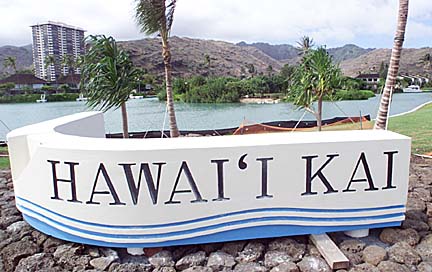

Alphabetic order differs from the normal Latin order in that the vowels come first, then the consonants. The current official Hawaiian alphabet consists of 13 letters: five vowels (A a, E e, I i, O o, and U u) and eight consonants (H h, K k, L l, M m, N n, P p, W w, and ʻ). The macron, or kahakō, was used to differentiate between short and long vowels. Kahakō Īs early as 1821, one of the missionaries, Hiram Bingham, was using macrons in making handwritten transcriptions of Hawaiian vowels. It was not until 1864 that the ʻokina became a recognized letter of the Hawaiian alphabet. In publishing the Hawaiian Bible, they used the ʻokina to distinguish koʻu ('my') from kou ('your'). As early as 1823, the missionaries made limited use of the apostrophe to represent the glottal stop, but they did not make it a letter of the alphabet. V was dropped, W was keptĭue to words with different meanings being spelled alike, use of the glottal stop became necessary. In 1826, the developers voted to eliminate some of the letters which represented functionally redundant interchangeable letters, enabling the Hawaiian alphabet to approach the ideal state of one-symbol-one-sound, and thereby optimizing the ease with which people could teach and learn the reading and writing of Hawaiian. In addition, the letters F, G, S, Y, and Z were used to spell foreign words. The original alphabet included five vowels and seven consonants: In 1822, a writing system based on one similar to the new New Zealand Grammar was developed and printed by American Protestant missionary Elisha Loomis. In his report, he wrote the name of the islands as "Owhyhee" or "Owhyee".

When Hawaiian language newspapers started, native-speaking writers and editors were careful to avoid these (the type that was available to "set" did not include such "specialty" characters).In 1778, British explorer James Cook made the first reported European voyage to Hawaiʻi. They still learned how unintended "double entendres" could be funny in written form. Since the intent was to translate the Bible ("Paipala"), natives forgave some of the confusion created. When the missionaries made a written form of Hawaiian Language, they did not write the kahakos or ʻokinas leaving it to the context to make the meanings evident. It talks of him (ia) eating (ai) his (iaia) fish (i ʻa). There is a children's rhyme that goes on for a couple of minutes (and written, probably a couple dozen lines) that consists of nothing but both versions of the letters a, i and the ʻokina. One might think that learning the language would be relatively easy, but that only applies to na keiki (children) who have never learned the 26 letters that English speakers use. The meanings (and pronunciations) of words spelled the same but with or without the appropriate kahakos or ʻokinas can be very different, sometimes even embarrassing. The other is extended, in written form, where a horizontal bar called a kahako is over the vowel. One is regular, where the vowel is pronounced as a Spaniard would say it. There are two forms of each of the five vowels. Most linguists, however, think it is because of internal phonological processes. Some think that final vowels helped the speakers remember chanted traditional stories and genealogies. There are some who think that makes the language sound "musical". People who live on that island are the only people who still speak Hawaiian only and their dialect is the truest to its roots.Įvery Hawaiian syllable ends with a vowel. The Ni ʻihau dialect still uses some T, S, R and "hints" of B sounds. The ʻokina is written as a backward apostrophe (small numeral 6 above and before a vowel). The ʻokina is pronounced as a glottal stop, like the break in the middle of the word "Uh-oh". The ʻokina is a real letter and came from some "K" sounds in old Polynesian languages. The language has only 12 letters (A, E, H, I, K, L, M, N, O, P, U, W). However, native speakers of all these languages can still understand each other. Their languages have changed a lot over the last two thousand years or so. There are related languages in the Marquesas, Raratonga, Samoa, some islands of what is now Fiji and New Zealand.


 0 kommentar(er)
0 kommentar(er)
